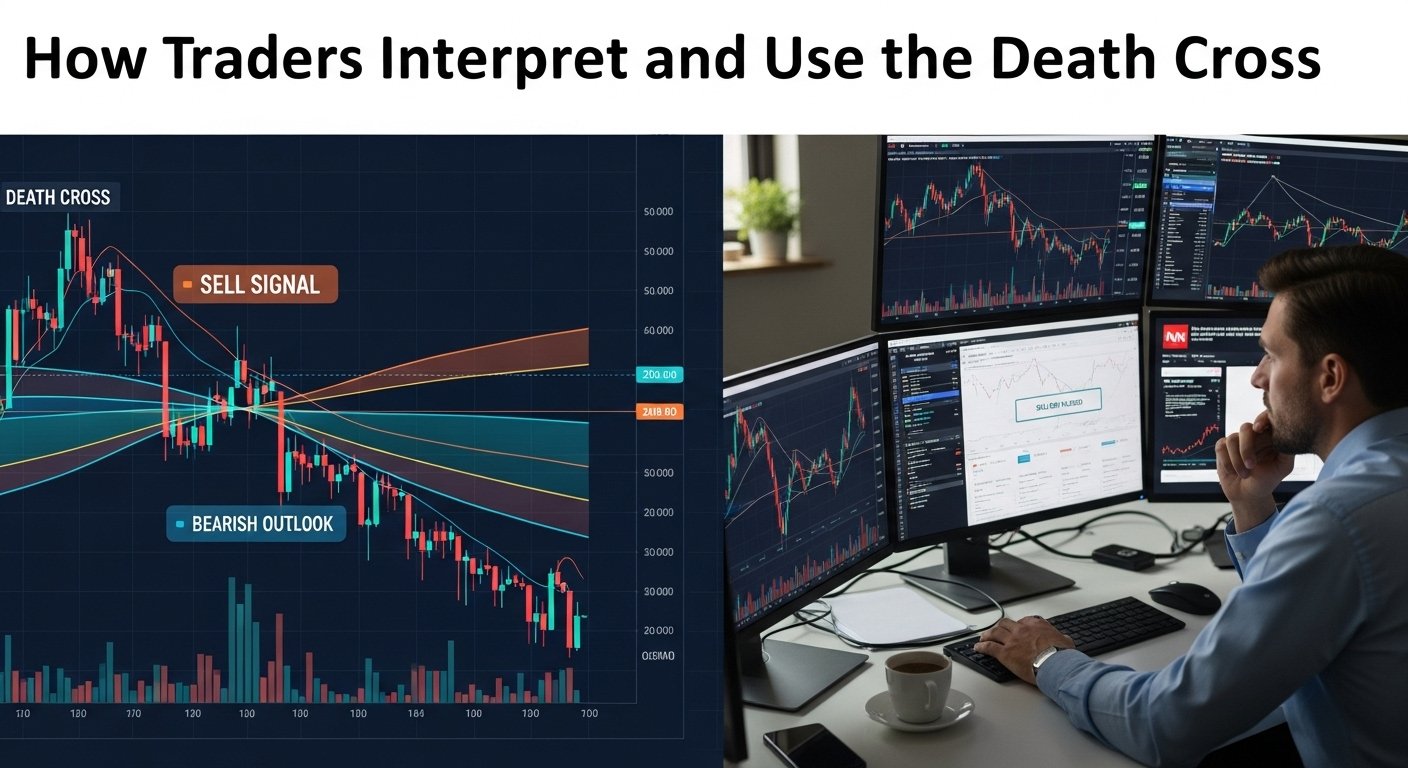Every time the cryptocurrency market turns volatile, traders and investors rush to interpret technical signals that might reveal where Bitcoin is heading next. Among these signals, the death cross remains one of the most dramatic and emotionally charged. When the phrase death cross confirmed begins to appear on news feeds and social media, confusion and speculation spread quickly. Some believe the death cross marks the beginning of a prolonged crash, while others argue it often appears close to major market bottoms and accumulation phases.
Understanding what the Bitcoin death cross truly represents requires more than reacting to dramatic headlines. It demands looking closely at historical cycles, broader market context, on-chain data, and the overall structure of price trends. This article explores the meaning behind the signal, why it forms, and whether the latest death cross indicates that Bitcoin is bottoming or preparing for another downward leg. By examining previous cycles and the mechanics of this pattern, readers can form a clearer understanding of how to interpret the death cross without fear or emotional bias.
What the Bitcoin Death Cross Actually Means
A death cross occurs when Bitcoin’s fifty-day simple moving average crosses below its two-hundred-day simple moving average. These averages smooth out short-term noise to reveal the underlying trend. When the short-term average drops beneath the long-term one, it implies that recent price performance has weakened enough to drag down the broader trend. This crossover is therefore considered a bearish signal.
However, the death cross is a lagging indicator. It forms only after sustained downward movement has already taken place. By the time traders see a confirmed death cross, a significant portion of the initial decline may already have passed. For this reason, the death cross often reflects what has already occurred rather than predicting what will happen next.
The opposite of the death cross is known as a golden cross, in which the fifty-day moving average crosses back above the two-hundred-day moving average. That signal is usually interpreted as bullish since it reflects strengthening short-term momentum relative to the long-term trend.
Understanding these mechanics is essential because it explains why the death cross should never be interpreted in isolation. It is one technical signal among many, and its real meaning depends entirely on where Bitcoin is within its broader cycle.
Why Traders Pay Attention to the Death Cross
Even though the death cross is a lagging indicator, it still holds psychological and strategic significance. Large institutional traders, algorithmic strategies, and many retail investors monitor moving average crossovers as part of their systems. When the death cross occurs, it often coincides with heightened fear, reduced risk appetite, and negative sentiment throughout the market.
This matters because markets are influenced not only by numbers but by human psychology. A widely recognized bearish signal can cause some traders to reduce exposure, close long positions, or hedge with shorts. This reaction can temporarily increase selling pressure, reinforcing the perception that Bitcoin is entering a period of weakness.

The death cross also often aligns with declining trading volume, reduced speculative activity, and less enthusiasm among new investors. These factors can contribute to extended consolidation phases. While this may appear negative at first, such conditions are also typical of long-term accumulation zones where stronger hands begin positioning gradually while weaker hands capitulate. For these reasons, the death cross is best understood as a reflection of market mood rather than a strict predictor of future price action.
Historical Analysis of Bitcoin Death Crosses
Examining past Bitcoin cycles provides valuable insight into whether the death cross tends to precede deeper crashes or instead appears near long-term bottoms. During the 2014 and 2015 bear market, Bitcoin experienced multiple death crosses as it unwound from the excitement of the 2013 rally. While some of these signals did accompany further declines, many occurred after substantial damage had already been done. When viewed through the lens of hindsight, several of these crossovers formed close to major accumulation phases where long-term investors quietly began building positions.
A similar dynamic unfolded during the 2018 crypto winter. Bitcoin had surged to nearly twenty thousand dollars before entering a long and painful decline. A death cross appeared relatively early in the bear market and was followed by additional downside that ultimately brought Bitcoin near three thousand dollars. That period demonstrated how a death cross can align with a genuine shift from bull to bear. However, it also shows how the signal tends to confirm a trend rather than lead it.
In contrast, the 2020 pandemic crash offers a very different example. When global markets collapsed, Bitcoin fell sharply and soon produced a death cross. Yet this particular death cross occurred remarkably close to a major multi-year buying opportunity. Bitcoin began recovering rapidly as global liquidity conditions improved, eventually reaching new all-time highs. This event demonstrates that a death cross can also appear near the beginning of a major reversal when the catalyst for recovery is strong enough.
Across all cycles, the consistent theme is that the death cross requires context to interpret correctly. Sometimes it accompanies a deeper decline, while other times it forms near a long-term bottom. In both cases, it tends to reflect what has already occurred rather than predicting what will definitely occur next.
Is Bitcoin Bottoming or About to Crash?
The key question traders ask when a death cross is confirmed is whether the signal indicates that Bitcoin is bottoming or preparing for further losses. Although there is no universal answer, several contextual clues offer guidance. The first context to examine is Bitcoin’s position relative to its previous highs and lows. When the death cross appears shortly after a major peak, the market may still be processing the shock of that reversal.
In such periods, additional volatility is common as the market searches for equilibrium. Conversely, when Bitcoin has already endured months of sideways movement or consolidation near the lower end of its range, a death cross may simply confirm conditions that have persisted for some time. In these situations, the market might be closer to forming a bottom than many realize.
The macroeconomic environment also plays a major role. Bitcoin tends to perform well in periods of abundant liquidity, rising risk appetite, and supportive financial conditions. In contrast, it struggles during tightening cycles, rising interest rates, or broader risk-off sentiment in global markets. When a death cross coincides with a hostile macro environment, traders may be more cautious. When it appears during improving macro conditions, it may be less impactful and short-lived.
On-chain metrics provide another layer of context. If long-term holders are accumulating while short-term holders are selling, it may indicate that the market is entering a bottoming phase. If both groups are distributing, further weakness is more likely. On-chain indicators such as realized price, market value to realized value ratios, miner behavior, and network activity can help determine whether the Bitcoin market is experiencing capitulation or merely entering a cooling phase.
How Traders Interpret and Use the Death Cross
Professional traders rarely use the death cross as a standalone trigger. Instead, they incorporate it into broader strategies that evaluate market structure, momentum, volume, and sentiment. Some traders use the death cross as a general trend filter. When the short-term moving average is below the long-term one, they may reduce their long exposure, avoid aggressive leverage, or shift to shorter time frames. This does not mean they panic or sell everything. Instead, they adjust risk and wait for clearer signs of trend reversal before committing significant capital.

Other traders treat the death cross as a warning signal rather than a definitive bearish conclusion. They watch closely for early signs of recovery such as higher lows on the chart, bullish divergences on momentum indicators, or rising volume on upward price movements. If Bitcoin begins reclaiming important support levels despite the moving averages still showing weakness, this can indicate an early reversal that is not yet reflected in the moving averages themselves.
Position sizing and risk management also play crucial roles. Traders who remain calm during death cross periods often do so because they have predetermined limits on risk instead of making emotional decisions. They consider their time horizon and strategy rather than reacting impulsively to a single technical pattern. In this way, the death cross becomes a component of disciplined trading rather than a source of fear.
The Long-Term Investor’s Interpretation
Long-term investors view death crosses through a very different lens compared to short-term traders. Instead of focusing on month-to-month fluctuations, they often examine broader economic trends, adoption rates, regulatory developments, and Bitcoin’s position as a scarce digital asset. For these investors, the death cross may simply reflect a temporary period of weakness that does not alter the long-term outlook.
Many long-term investors use dollar-cost averaging strategies during bearish conditions. They see death cross periods as opportunities to accumulate at lower prices rather than as signals to exit the market. Because moving averages lag behind real price action, relying solely on them can cause investors to sell low during fear and buy high during euphoria. Those who maintain a long-term perspective often find that steadiness during periods of fear is rewarded over multi-year horizons.
At the same time, long-term investors remain cautious about overexposure. While they may not react strongly to the death cross itself, they continue to assess the overall health of the market and their personal risk tolerance. Their decisions are driven not by the crossover, but by their conviction in Bitcoin’s long-term utility and the broader economic landscape.
Misunderstandings Surrounding the Death Cross
Because the term death cross sounds ominous, many misconceptions surround it. Some traders assume it always predicts a massive crash. Others dismiss it as meaningless. Both interpretations overlook important nuance. The death cross does not guarantee a crash. In several cycles, Bitcoin has rallied significantly after the crossover. The death cross is also not irrelevant. It does accurately depict that the short-term trend has weakened significantly relative to the long-term trend. When understood as a trend confirmation signal rather than a timing tool, it becomes far more useful.
Another misconception is that traders must immediately sell upon seeing a confirmed death cross. This rigid approach often leads to poor outcomes because it ignores the complexity of market structure. Selling solely because of a death cross can trap traders into exiting near the lows and then buying back only after a golden cross appears, which may occur well after a major rally has already begun. The opposite error is ignoring the signal entirely. Dismissing the death cross deprives traders of a useful perspective on trend deterioration. The correct approach lies between these extremes and involves using the death cross as one data point among many.
Making Sense of the Death Cross in Real Time
When a death cross forms, traders can benefit from approaching the situation with a structured mindset rather than rushing to conclusions. The first step is understanding that moving averages reflect the past, not the future. The second is analyzing whether the broader market environment supports the possibility of further decline or hints at a potential recovery.
The market structure, global economic conditions, institutional behavior, and on-chain patterns all influence how meaningful the death cross will be. A trader who evaluates these elements calmly will make better decisions than one who responds emotionally to the term death cross alone.
The most successful investors and traders understand that Bitcoin’s long-term potential does not vanish during bearish signals. At the same time, they respect the risks present during weakening trends and adjust accordingly. This balance between caution and conviction is critical during transitional periods marked by technical signals such as the death cross.
Also Read: Bitcoin News Today BTC Price Rebounds 4% on Macro Relief
Conclusion
The confirmation of a Bitcoin death cross often sparks intense debate among traders who wonder whether Bitcoin is bottoming or preparing for a deeper crash. History shows that the death cross can align with both outcomes depending on the context in which it appears. It is neither a definitive crash indicator nor a reliable bottom signal on its own. Instead, it reflects a period of sustained weakness and declining momentum that requires thoughtful interpretation.
By examining Bitcoin’s position within its broader cycle, evaluating macroeconomic conditions, studying on-chain metrics, and maintaining a disciplined strategy, both traders and long-term investors can use the death cross as one component of a comprehensive approach rather than as a source of panic. Understanding the nuances behind the signal allows market participants to respond intelligently instead of emotionally.
FAQs
Q: What causes the Bitcoin death cross to form?
The Bitcoin death cross forms when the fifty-day moving average drops below the two-hundred-day moving average. This indicates that short-term price performance has weakened enough to pull down the longer-term trend, reflecting sustained downward momentum.
Q: Does the death cross always predict a major price crash?
The death cross does not always lead to a significant crash. In some cycles, it has been followed by further declines, while in others it has formed near major market bottoms. It is a lagging indicator and should always be interpreted within broader market context.
Q: Can the death cross appear during a long-term bull market?
The death cross can occur during corrections within a bull market if short-term momentum deteriorates enough. In such cases, it may mark a temporary cooling period rather than a complete trend reversal.
Q: How do long-term investors react to a death cross?
Long-term investors often view death cross periods as opportunities to accumulate Bitcoin at lower prices. They focus more on multi-year trends, adoption, and fundamentals rather than reacting to every technical signal.
Q: Is the death cross useful for trading strategies?
The death cross can be useful when incorporated into a broader trading strategy. It should not be used in isolation but can help traders gauge the overall trend, manage risk, and adjust exposure during periods of weakening momentum.

